Superregnum: Eukaryota
Regnum: Animalia
Subregnum: Eumetazoa
Cladus: Bilateria
Cladus: Nephrozoa
Superphylum: Deuterostomia
Phylum: Chordata
Cladus: Craniata
Subphylum: Vertebrata
Infraphylum: Gnathostomata
Superclassis: Tetrapoda
Cladus: Reptiliomorpha
Cladus: Amniota
Cladus: Synapsida
Cladus: Eupelycosauria
Cladus: Sphenacodontia
Cladus: Sphenacodontoidea
Ordo: Therapsida
Cladus: Theriodontia
Subordo: Cynodontia
Cladus: Mammaliaformes
Classis: Mammalia
Subclassis: Trechnotheria
Infraclassis: Zatheria
Supercohort: Theria
Cohort: Eutheria
Cohort: Placentalia
Cladus: Boreoeutheria
Superordo: Laurasiatheria
Cladus: Ferae
Ordo: Carnivora
Subordo: Feliformia
Familia: Viverridae
Subfamiliae: Hemigalinae - Paradoxurinae - Viverrinae
Name
Viverridae Gray, 1821
Vernacular names
Internationalization
Dansk: Desmerdyr
Deutsch: Schleichkatzen
English: Civets, Genets, & Linsangs
Français: Viverridé
Hrvatski: Cibetke
日本語: ジャコウネコ科
Nederlands: Civetkatachtigen
Norsk (bokmål): Snikekatter
Polski: Łaszowate
Português: Civeta
Svenska: Sibetdjur (Viverrider) tr=Misk kedisigiller
Українська: Виверові
References
Viverridae in Mammal Species of the World.
Mammal Species of the World: A Taxonomic and Geographic Reference, 2 Volume Set edited by Don E. Wilson, DeeAnn M. Reeder.
London Med. Repos. 1821: 301.
Wilson, D.E. & Reeder, D.M. (eds.) 2005. Mammal Species of the World: a taxonomic and geographic reference. 3rd edition. The Johns Hopkins University Press: Baltimore. 2 volumes. 2142 pp. ISBN 978-0-8018-8221-0. Reference page.
Vernacular names
беларуская: Віверавыя
dansk: Desmerdyr
Deutsch: Schleichkatzen
English: Viverrids
français: Viverridé
עברית: גחניים
hrvatski: Cibetke
italiano: Viverridi
日本語: ジャコウネコ科
Nederlands: Civetkatachtigen
norsk: Snikekatter
polski: Łaszowate
português: Viverrídeos
svenska: Sibetdjur (Viverrider)
ไทย: ชะมด, อีเห็น
Türkçe: Misk kedisigiller
українська: Виверові
Tiếng Việt: Họ Cầy
Viverridae is a family of small to medium-sized mammals, the viverrids (/vaɪˈvɛrɪdz/), comprising 14 genera, which are subdivided into 33 species. This family was named and first described by John Edward Gray in 1821.[3] Viverrids occur all over Africa, southern Europe, and South and Southeast Asia, across the Wallace Line. Their occurrence in Sulawesi and in some of the adjoining islands shows them to be ancient inhabitants of the Old World tropics.[4]
Characteristics
Binturong (Arctictis binturong) on display at the Museum of Osteology
Viverrids have four or five toes on each foot and half-retractile claws. They have six incisors in each jaw and molars with two tubercular grinders behind in the upper jaw, and one in the lower jaw. The tongue is rough with sharp prickles. A pouch or gland occurs beneath the anus, but there is no cecum.[3]
Viverrids are the most primitive of all the families of feliform Carnivora and clearly less specialized than the Felidae. In external characteristics, they are distinguished from the Felidae by the longer muzzle and tuft of facial vibrissae between the lower jaw bones, and by the shorter limbs and the five-toed hind foot with the first digit present. The skull differs by the position of the postpalatine foramina on the maxilla, almost always well in advance of the maxillopalatine suture, and usually about the level of the second premolar; and by the distinct external division of the auditory bulla into its two elements either by a definite groove or, when rarely this is obliterated, by the depression of the tympanic bone in front of the swollen entotympanic. The typical dental formula is: 3.1.4.23.1.4.2, but the number may be reduced, although never to the same extent as in the Felidae.[4]
Their flesh-shearing carnassial teeth are relatively undeveloped compared to those of other feliform carnivores.[5] Most viverrid species have a penis bone (a baculum).[6]
Classification
Living species
In 1821, Gray defined this family as consisting of the genera Viverra, Genetta, Herpestes, and Suricata.[3] Reginald Innes Pocock later redefined the family as containing a great number of highly diversified genera, and being susceptible of division into several subfamilies, based mainly on the structure of the feet and of some highly specialized scent glands, derived from the skin, which are present in most of the species and are situated in the region of the external generative organs. He subordinated the subfamilies Hemigalinae, Paradoxurinae, Prionodontinae, and Viverrinae to the Viverridae.[4]
In 1833, Edward Turner Bennett described the Malagasy fossa (Cryptoprocta ferox) and subordinated the Cryptoprocta to the Viverridae.[7] A molecular and morphological analysis based on DNA/DNA hybridization experiments suggests that Cryptoprocta does not belong within Viverridae, but is a member of the Eupleridae.[8]
The African palm civet (Nandinia binotata) resembles the civets of the Viverridae, but is genetically distinct and belongs in its own monotypic family, the Nandiniidae. There is little dispute that the Poiana species are viverrids.[2]
DNA analysis based on 29 Carnivora species, comprising 13 Viverrinae species and three species representing Paradoxurus, Paguma and Hemigalinae, confirmed Pocock's assumption that the African linsang Poiana represents the sister group of the genus Genetta. The placement of Prionodon as the sister group of the family Felidae is strongly supported, and it was proposed that the Asiatic linsangs be placed in the monogeneric family Prionodontidae.[9]
Family Viverridae[1][2][10]
| Subfamily | Genus | Species | Image of type species |
|---|---|---|---|
| Viverrinae | Viverra Linnaeus, 1758[11] |
|
 |
| Viverricula Hodgson, 1838[14] | Small Indian civet (V. indica) (Geoffroy Saint-Hilaire, 1803)[15] |  |
|
| Civettictis Pocock, 1915[16] | African civet (C. civetta) (Schreber, 1776)[17] | 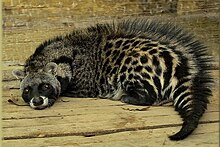 |
|
| Hemigalinae Gray, 1864[18] | |||
| Hemigalus Jourdan, 1837[19] | Banded palm civet (H. derbyanus) Jourdan, 1837[19] | 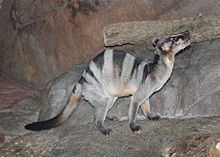 |
|
| Cynogale Gray, 1836[20] | Otter civet (C. bennettii) Gray, 1836[20] | 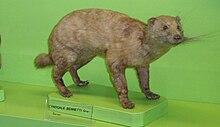 |
|
| Diplogale Thomas, 1912[21] | Hose's palm civet (D. hosei) (Thomas, 1892)[22] | 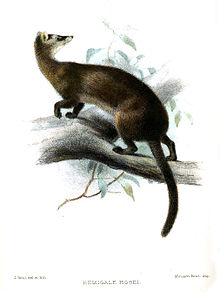 |
|
| Macrogalidia Schwarz, 1910[23] | Sulawesi palm civet (M. musschenbroekii) (Schlegel, 1877)[24] | 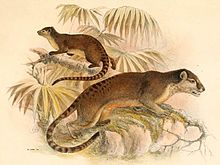 |
|
| Chrotogale Thomas, 1912[21] | Owston's palm civet (C. owstoni) Thomas, 1912[21] | 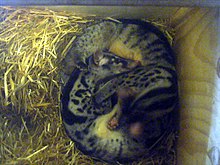 |
|
| Paradoxurinae Gray, 1864[18] | Paradoxurus Cuvier, 1822[25] |
|
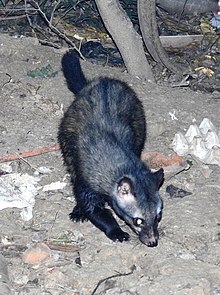 |
| Arctictis Temminck, 1824[29] | Binturong (A. binturong) (Raffles, 1822)[30] | 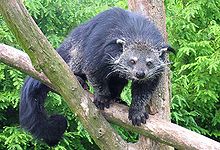 |
|
| Paguma Gray, 1831[31] | Masked palm civet (P. larvata) (Smith, 1827)[32] |  |
|
| Arctogalidia Merriam, 1897[33] | Small-toothed palm civet (A. trivirgata) (Gray, 1832)[34] |  |
|
| Genettinae | Genetta Cuvier, 1816[35] |
|
 |
| Poiana Gray, 1864[18] |
|
 |
Phylogeny
The phylogenetic relationships of Viverridae are shown in the following cladogram:[1][10]
| Viverridae |
|
Extinct species
| Subfamily | Genus | Species |
|---|---|---|
| Viverrinae | Viverra Linnaeus, 1758 | Leakey's civet (V. leakeyi) Leakey, 1982 |
| Semigenetta Helbing 1927 |
|
|
| Paradoxurinae | Kichechia Savage, 1965[50] |
|
| Tugenictis Morales & Pickford, 2005[52][53] | †T. ngororaensis[52] Morales & Pickford, 2005 | |
| Kanuites Dehghani & Werdelin, 2008[54] | †K. lewisae[54] Dehghani & Werdelin, 2008 | |
| Siamictis Grohé et al., 2020[55] | †S. carbonensis[55] Grohé et al., 2020 |
See also
List of viverrids
References
Gaubert, P. & Cordeiro-Estrela, P. (2006). "Phylogenetic systematics and tempo of evolution of the Viverrinae (Mammalia, Carnivora, Viverridae) within feliformians: implications for faunal exchanges between Asia and Africa" (PDF). Molecular Phylogenetics and Evolution. 41 (2): 266–278. doi:10.1016/j.ympev.2006.05.034. PMID 16837215.open access
Wozencraft, W. C. (2005). "Family Viverridae". In Wilson, D. E.; Reeder, D. M. (eds.). Mammal Species of the World: A Taxonomic and Geographic Reference (3rd ed.). Johns Hopkins University Press. pp. 548–559. ISBN 978-0-8018-8221-0. OCLC 62265494.
Gray, J. E. (1821). "On the natural arrangement of vertebrose animals". London Medical Repository. 15 (1): 296–310.
Pocock, R. I. (1939). "Family Viverridae". The Fauna of British India, including Ceylon and Burma. Mammalia. – Volume 1. London: Taylor and Francis. pp. 330–332.
Wozencraft, W. C. (1984). Macdonald, D. (ed.). The Encyclopedia of Mammals. New York: Facts on File. pp. 134–135. ISBN 0-87196-871-1.
Ewer, R. F. (1998). The Carnivores. Cornell University Press. ISBN 0-8014-8493-6.
Bennett, E. T. (1833). "Notice of a new genus of Viverridous Mammalia from Madagascar". Proceedings of the Zoological Society of London. 1833: 46.
Veron, G.; Catzeflis, F. M. (1993). "Phylogenetic relationships of the endemic Malagasy carnivore Cryptoprocta ferox (Aeluroideae): DNA/DNA hybridization experiments". Journal of Mammalian Evolution. 1 (3): 169–185. doi:10.1007/bf01024706. S2CID 21555307.
Gaubert, P.; Veron, G. (2003). "Exhaustive sample set among Viverridae reveals the sister-group of felids: the linsangs as a case of extreme morphological convergence within Feliformia". Proceedings of the Royal Society B: Biological Sciences. 270 (1532): 2523–2530. doi:10.1098/rspb.2003.2521. PMC 1691530. PMID 14667345.
Nyakatura, K. & Bininda-Emonds, O. R. P. (2012). "Updating the evolutionary history of Carnivora (Mammalia): a new species-level supertree complete with divergence time estimates". BMC Biology. 10: 12. doi:10.1186/1741-7007-10-12. PMC 3307490. PMID 22369503.
Linnaeus, C. (1758). "Viverra". Systema naturæ per regna tria naturæ, secundum classes, ordines, genera, species, cum characteribus, differentiis, synonymis, locis 1 (Tenth ed.). Stockholm: Laurentius Salvius. pp. 43–45.
Gray, J. E. (1832). "On the family of Viverridae and its generic sub-divisions, with an enumeration of the species of several new ones". Proceedings of the Committee of Science and Correspondence of the Zoological Society of London. 2: 63–68.
Blyth, E. (1862). "Report of Curator, Zoological Department, February 1862". The Journal of the Asiatic Society of Bengal. 31 (3): 331–345.
Hodgson, B. H. (1838). "Classified Catalogue of Nepalese Mammalia". Annals of Natural History. 1 (2): 152−154.
Geoffroy Saint-Hilaire, E. (1803). "La Civette de l'Inde". Catalogue des Mammifères du Museum National d'Histoire Naturelle. Paris: Museum National d'Histoire Naturelle. p. 113.
Pocock, R. I. (1915). "On the Feet and Glands and other External Characters of the Viverrinae, with the description of a New Genus". Proceedings of the Zoological Society of London: 131−149.
Schreber, J. C. D. (1778). "Die Civette Viverra civetta". Die Säugethiere in Abbildungen nach der Natur, mit Beschreibungen. Erlangen: Wolfgang Walther. pp. 418–420.
Gray, J. E. (1864). "A revision of the genera and species of viverrine animals (Viverridae), founded on the collection in the British Museum". Proceedings of the Zoological Society of London for the Year 1864: 502–579.
Jourdan, C. (1837). "Mémoire sur deux mammifères nouveaux de l'Inde, considérés comme types des deux genres voisins des Paradoxures, genres Hémigale et Ambliodon". Comptes rendus hebdomadaires des séances de l'Académie des sciences: 442–447.
Gray, J.E. (1836). "Characters of some new species of Mammalia in the Society's collection". Proceedings of the Zoological Society of London. Part IV (October): 87–88.
Thomas, O. (1912). "Two new Genera and a Species of Viverrine Carnivora". Proceedings of the Zoological Society of London. Part II: 498–503.
Thomas, O. (1892). "On some Mammals form Mount Dulit, North Borneo". Proceedings of the Zoological Society of London. Part I: 221–226.
Schwarz, E. (1910). "Notes on some Palm-Civets". The Annals and Magazine of Natural History; Zoology, Botany, and Geology. 8. 5 (29): 422–424.
Schlegel, H. (1879). "Paradoxurus musschenbroekii". Notes from the Royal Zoological Museum of the Netherlands at Leyden. 1 (Note XIV): 43.
Cuvier, F. (1822). "Du genre Paradoxure et de deux espèces nouvelles qui s'y rapportent". Mémoires du Muséum d'Histoire Naturelle Paris. 9: 41–48.
Pallas, P. S. (1778). "Das Zwitterstinkthier". In Schreber, J. C. D. (ed.). Die Säugethiere in Abbildungen nach der Natur, mit Beschreibungen. Erlangen: Wolfgang Walther. p. 426.
Pallas, P. S. (1778). "Der Boshond". In Schreber, J. C. D. (ed.). Die Säugethiere in Abbildungen nach der Natur, mit Beschreibungen. Erlangen: Wolfgang Walther. p. 451.
Blanford, W. T. (1885). "A Monograph of the Genus Paradoxurus, F. Cuvier". Proceedings of the Zoological Society of London. 53 (4): 780–808. doi:10.1111/j.1096-3642.1885.tb02921.x.
Temminck, C. J. (1824). "XVII Genre Arctictis". Monographies de mammalogie. Paris: Dufour & d'Ocagne. p. xxi.
Raffles, T. S. (1822). "XVII. Descriptive Catalogue of a Zoological Collection, made on account of the Honourable East India Company, in the Island of Sumatra and its Vicinity, under the Direction of Sir Thomas Stamford Raffles, Lieutenant-Governor of Fort Marlborough', with additional Notices illustrative of the Natural History of those Countries". The Transactions of the Linnean Society of London. XIII: 239–274.
Gray, J. E. (1831). "Paguma". Proceedings of the Committee of Science and Correspondence of the Zoological Society of London. 1. London: Zoological Society of London. p. 95.
Smith, C.H. (1827). "Gulo larvatus, the Masked Glutton". In Griffith, E. (ed.). The animal kingdom : arranged in conformity with its organization. 2. Mammalia. London: G.B. Whittaker. p. 281.
Merriam, C. H. (1897). "The generic names Ictis, Arctogale, and Arctogalidia". Science. 5 (112): 302. doi:10.1126/science.5.112.302. PMID 17741859.
Gray, J.E. (1832). "On the Family of Viverridae and its generic subdivisions; with an enumeration of the Species of Paradoxurus, and Characters of several new ones". Proceedings of the Committee of Science and Correspondence of the Zoological Society of London (Part 2): 63–68.
Cuvier, F. (1816). Cuvier, G. (ed.). Le règne animal distribué d'après son organisation, pour servir de base à l'histoire naturelle des animaux et d'introduction à l'anatomie comparée. I. Paris: Deterville.
Linnaeus, C. (1758). "Viverra genetta". Systema naturæ per regna tria naturæ, secundum classes, ordines, genera, species, cum characteribus, differentiis, synonymis, locis 1 (Tenth ed.). Stockholm: Laurentius Salvius. p. 45.
Schreber, J. C. D. (1778). "Die Bisamkaze Viverra tigrina". Die Säugethiere in Abbildungen nach der Natur mit Beschreibungen. Dritter Theil. Erlangen: Walther. pp. 425–426.
Thunberg, C. P. (1811). "Beskrifning och teckning pa Viverra felina". Kungliga Swenska Wetenskaps Academiens Handlingar: 165–168.
Gray, J. E. (1828). "Viverra maculata". Spicilegia zoologica : original figures and short systematic descriptions of new and unfigured animals. London: Treuttel, Wurtz & Co. p. 9.
Geoffroy Saint-Hilaire, I. (1832). "Descriptions d'une nouvelle espèce du genre Genette. Genetta. Cuv.". Études Zoologiques : Ouvrage comprenant l'histoire et la description d'un grand nombre d'animaux récemment découverts et des observations nouvelles sur plusieurs genres déjà connus. Paris: Lequien Fils. p. 73.
Rüppell, E. (1835). "Viverra abyssinica. Rüppell". Neue Wirbelthiere zu der Fauna von Abyssinien gehörig. Frankfurt: Siegmund Schmerber.
Waterhouse, G. R. (1838). "On some New Species of Mammalia from Fernando Po". Proceedings of the Zoological Society of London: 57–61.
Thomas, O. (1901). "On the more notable Mammals obtained by Sir Harry Johnston in the Uganda Protectorate". Proceedings of the Zoological Society of London. II: 85–90.
Matschie, P. (1902). "Über die individuellen und geographischen Abänderungen der Ginsterkatzen". Verhandlungen des V. Internationalen Zoologen-Congresses zu Berlin, 12.–16. August 1901. Jena: Gustav Fischer. pp. 1128–1145.
Thomas, O. & Schwann, H. (1906). "The Rudd Exploration of South Africa.—IV. List of Mammals obtained by Mr. Grant at Knysna". Proceedings of the Zoological Society of London. 76 (1–2): 159–168. doi:10.1111/j.1469-7998.1906.tb08427.x.
Allen, J. A. (1919). "Preliminary notes on African carnivora". Journal of Mammalogy. 1 (1): 23–31. doi:10.2307/1373716. JSTOR 1373716.
Gaubert, P. (2003). "Description of a new species of genet (Carnivora; Viverridae; genus Genetta) and taxonomic revision of forest forms related to the Large-spotted Genet complex". Mammalia. 67 (1): 85–108. doi:10.1515/mamm.2003.67.1.85. S2CID 84351854.
Thomson, T. R. H. (1842). "Description of a new species of Genetta, and of two species of Birds from Western Africa". The Annals and Magazine of Natural History; Zoology, Botany, and Geology. 10 (64): 203–205. doi:10.1080/03745484209445224.
Pocock, R. I. (1907). "Report upon a Small Collection of Mammalia brought from Liberia by Mr. Leonard Leighton". Proceedings of the Zoological Society of London (November): 1037–1046.
Savage, R. J. G. (1965). "Fossil mammals of Africa: 19, The Miocene Carnivora of East Africa". Bulletin of the British Museum (Natural History). 10 (8): 239–316.
Adrian, B.; Werdelin, L. & Grossman, A. (2018). "New Miocene Carnivora (Mammalia) from Moruorot and Kalodirr, Kenya" (PDF). Palaeontologia Electronica. 21 (1 10A): 1–19. doi:10.26879/778.
Morales, J. & Pickford, M. (2005). "Carnivores from the Middle Miocene Ngorora Formation (13-12 Ma), Kenya" (PDF). Estudios Geológicos. 61 (3–6): 271–284. doi:10.3989/egeol.05613-668.
Werdelin, L. (2019). "Middle Miocene Carnivora and Hyaenodonta from Fort Ternan, western Kenya" (PDF). Geodiversitas. 41 (6): 267. doi:10.5252/geodiversitas2019v41a6. S2CID 146620949.
Dehghani, R. & Werdelin, L. (2008). "A new small carnivoran from the Middle Miocene of Fort Ternan, Kenya". Neues Jahrbuch für Geologie und Paläontologie - Abhandlungen. 248 (2): 233–244. doi:10.1127/0077-7749/2008/0248-0233.
Grohé, C.; Bonis, L. D.; Chaimanee, Y.; Chavasseau, O.; Rugbumrung, M.; Yamee, C.; Suraprasit, K.; Gibert, C.; Surault, J.; Blondel, C.; Jaeger, J.-J. (2020). "The Late Middle Miocene Mae Moh Basin of Northern Thailand: The Richest Neogene Assemblage of Carnivora from Southeast Asia and a Paleobiogeographic Analysis of Miocene Asian Carnivorans". American Museum Novitates (3952): 1–57. doi:10.1206/3952.1. S2CID 219296152.
Retrieved from "http://en.wikipedia.org/"
All text is available under the terms of the GNU Free Documentation License

